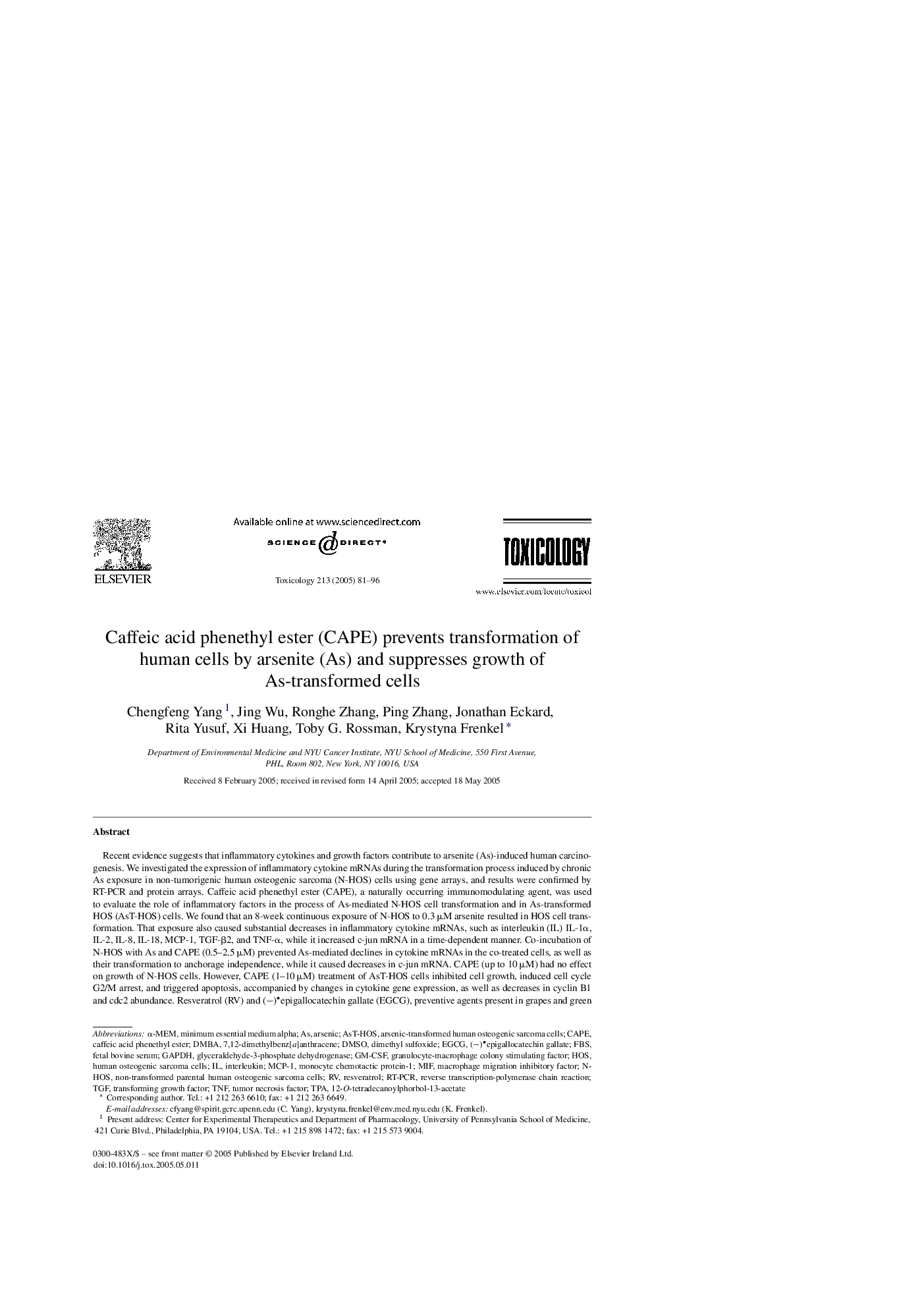| کد مقاله | کد نشریه | سال انتشار | مقاله انگلیسی | نسخه تمام متن |
|---|---|---|---|---|
| 9034618 | 1562443 | 2005 | 16 صفحه PDF | دانلود رایگان |
عنوان انگلیسی مقاله ISI
Caffeic acid phenethyl ester (CAPE) prevents transformation of human cells by arsenite (As) and suppresses growth of As-transformed cells
دانلود مقاله + سفارش ترجمه
دانلود مقاله ISI انگلیسی
رایگان برای ایرانیان
کلمات کلیدی
GAPDHα-MEMDMBAMCP-1Cyclin B112-O-tetradecanoylphorbol-13-acetateTGFRT-PCRGM-CSFEGCGtPATNFCAPEFBSgranulocyte-macrophage colony stimulating factorcdc27,12-Dimethylbenz[a]anthracene - 7،12-Dimethylbenz [a] آنتراسنHOS - ATDMSO - DMSOArsenic - آرسنیکcaffeic acid phenethyl ester - اسید کافئیک اسید فین الی استرinterleukin - اینترلوکینtransforming growth factor - تبدیل فاکتور رشدApoptosis - خزان یاختهایCell growth arrest - دستگیری رشد سلولیDimethyl sulfoxide - دیمتیل سولفواکسیدResveratrol - رسوراترولfetal bovine serum - سرم جنین گاوInflammatory cytokines - سیتوکین های التهابیMIF - شهرMacrophage migration inhibitory factor - عامل مهارکننده مهاجرت ماکروفاژtumor necrosis factor - فاکتور نکروز تومورreverse transcription-polymerase chain reaction - واکنش زنجیره ای رونویسی-پلیمراز معکوسMonocyte chemotactic protein-1 - پروتئین chemotactic monocyte-1Prevention - پیشگیریglyceraldehyde-3-phosphate dehydrogenase - گلیسرالیدید-3-فسفات دهیدروژناز
موضوعات مرتبط
علوم زیستی و بیوفناوری
علوم محیط زیست
بهداشت، سم شناسی و جهش زایی
پیش نمایش صفحه اول مقاله

چکیده انگلیسی
Recent evidence suggests that inflammatory cytokines and growth factors contribute to arsenite (As)-induced human carcinogenesis. We investigated the expression of inflammatory cytokine mRNAs during the transformation process induced by chronic As exposure in non-tumorigenic human osteogenic sarcoma (N-HOS) cells using gene arrays, and results were confirmed by RT-PCR and protein arrays. Caffeic acid phenethyl ester (CAPE), a naturally occurring immunomodulating agent, was used to evaluate the role of inflammatory factors in the process of As-mediated N-HOS cell transformation and in As-transformed HOS (AsT-HOS) cells. We found that an 8-week continuous exposure of N-HOS to 0.3 μM arsenite resulted in HOS cell transformation. That exposure also caused substantial decreases in inflammatory cytokine mRNAs, such as interleukin (IL) IL-1α, IL-2, IL-8, IL-18, MCP-1, TGF-β2, and TNF-α, while it increased c-jun mRNA in a time-dependent manner. Co-incubation of N-HOS with As and CAPE (0.5-2.5 μM) prevented As-mediated declines in cytokine mRNAs in the co-treated cells, as well as their transformation to anchorage independence, while it caused decreases in c-jun mRNA. CAPE (up to 10 μM) had no effect on growth of N-HOS cells. However, CAPE (1-10 μM) treatment of AsT-HOS cells inhibited cell growth, induced cell cycle G2/M arrest, and triggered apoptosis, accompanied by changes in cytokine gene expression, as well as decreases in cyclin B1 and cdc2 abundance. Resveratrol (RV) and (â)epigallocatechin gallate (EGCG), preventive agents present in grapes and green tea, respectively, induced similar changes in AsT-HOS cell growth but required much higher doses than CAPE to cause 50% growth arrest (<2.5 μM CAPE versus 25 μM RV or 50 μM EGCG). Overall, our findings suggest that inflammatory cytokines play an important role in the suppressive effects of CAPE on As-induced cell transformation and in the selective cytotoxicity of CAPE to As-transformed HOS cells.
ناشر
Database: Elsevier - ScienceDirect (ساینس دایرکت)
Journal: Toxicology - Volume 213, Issues 1â2, 15 September 2005, Pages 81-96
Journal: Toxicology - Volume 213, Issues 1â2, 15 September 2005, Pages 81-96
نویسندگان
Chengfeng Yang, Jing Wu, Ronghe Zhang, Ping Zhang, Jonathan Eckard, Rita Yusuf, Xi Huang, Toby G. Rossman, Krystyna Frenkel,